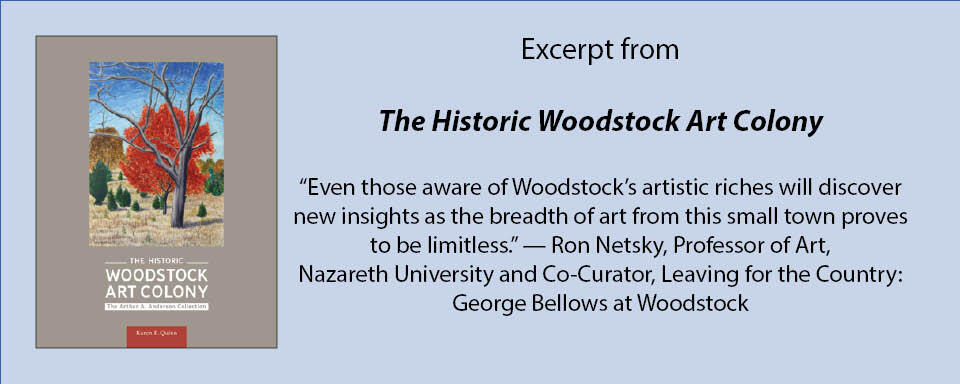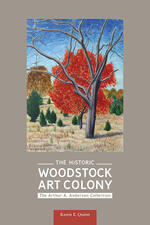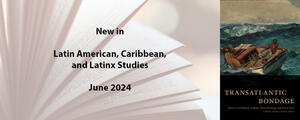
Excerpt: The Historic Woodstock Art Colony
The Historic Woodstock Art Colony: The Arthur A. Anderson Collection, by Karen E. Quinn, explores the remarkable range of artists who have worked in Woodstock, New York for over a century.
On the second page of The Historic Woodstock Art Colony is a 1926 map of Woodstock, diagramming the locations of dozens of artist’s studios. The small town at the edge of the Catskill Mountains boasted artistic giants like George Bellows, Peggy Bacon, Birge Harrison, Doris Lee, George Ault and many others. This book illuminates their lives and works in essays by curator Karen E. Quinn and a host of Woodstock scholars. Even those aware of Woodstock’s artistic riches will discover new insights as the breadth of art from this small town proves to be limitless." — Ron Netsky, Professor of Art, Nazareth University and Co-Curator, Leaving for the Country: George Bellows at Woodstock
"A book as thoughtful and thematically wide-ranging as the collection it honors. Arthur Anderson's appreciation that the Woodstock Art Colony defies a single art historical "ism" pushed him to invest in an astonishing assortment of subjects and styles, a breadth paralleled in the book’s essays—from family reminiscences and celebrations of friendship to incisive visual inquiry and biography. A beautifully illustrated tribute to Anderson’s landmark gift to the New York State Museum, sure to please both veteran Woodstockers and the newly curious." — Derin Tanyol, Curator of Modern and Contemporary Art, The Hyde Collection
The following is an excerpt from The Historic Woodstock Art Colony
BIRGE HARRISON AND THE WOODSTOCK SCHOOL OF LANDSCAPE PAINTING
Bruce Weber
The Woodstock School of Landscape Painting was in operation from 1906–1922 under the auspices of the Art Students League of New York. The school’s first teacher and director was Birge Harrison, who had a major impact on the art produced in the art colony’s early years. Harrison originally came to Woodstock in 1904 when he accepted his friend Ralph Radcliffe Whitehead’s offer to teach at Byrdcliffe and take over Hermann Dudley Murphy’s position as the painting instructor and head of the school. After a summer of teaching at Byrdcliffe, Harrison took a year’s sabbatical so that he could devote himself fully to painting. In 1905 the Art Students League in New York decided to move their summer school from Old Lyme, Connecticut, where it had been in operation for four years under the leadership of Frank Vincent DuMond. John F. Carlson, who studied with Harrison at Byrdcliffe, suggested moving the school to Woodstock and helped recruit Harrison for the job. He served as Harrison’s assistant and followed him as the director of the school from 1911–1917. Harrison settled in Woodstock for the remainder of his life but spent extensive time away.
By the time of his arrival in Woodstock, Harrison was working in the soft, ethereal atmospheric Tonalist style for which he became well-known. In the 1890s, he had come under the stylistic sway of the landscape paintings of James Abbott McNeil Whistler. Whistler’s landscapes inspired several American artists to adopt an interest in tonal painting, employ the use of a single, dominant color, and translate the spirit and mood of nature through the expressive simplification of color, line, and composition. His followers joined with other American landscape painters of the period, many of whom were inspired by the late works of George Inness and similarly come under the stylistic banner of Tonalism. The artists viewed nature as an agent for transporting the soul to a pure and ideal state—one where man contemplates the beauty and harmony of the natural world and the immaterial aspects of the universe. The Tonalists were drawn to the cultivated landscapes common to the French Barbizon School.
In Woodstock, Harrison favored painting snow-covered low-lying rural wintertime landscapes in the lowering light of day or featuring the rising moon. He typically liked to include a stream or waterway running back into the distance, where forms are vaguely defined. He utilized warm colors to enliven cooler hues and favored asymmetrical compositions—an outgrowth of his study and admiration of Japanese prints. Sometimes he chose to accentuate the emptiness of the setting and included a lone figure in the composition.
Under Harrison’s influence, Woodstock’s landscape painters favored picturing fragmentary or spare bits of nature (such as the corner of a field, a glimpse of a waterway or forest interior, a simple line of trees, or an empty or near empty parcel of land). They were interested and sensitive to abstract design, and often indicated the presence of human life and settlement through the inclusion of a clearing, fence, path, vehicle, barn or house. Other concerns revolved around the evocation of mood, fluid brushwork, and a palette dominated by a single hue.
In 1912, a year after retiring from teaching at the League’s school, Harrison authored the article “Painting at Woodstock: The Work of a Group of American Landscape Painters.” He praised the ambitions and accomplishments of the school, which he believed had “become the most important and successful institution of its kind in the world,” lauding the subjects within half a mile of the white steeple of the old Dutch Reformed Church, which marks the center of the village community. First, there is the winding Sawkill, with its mills, its falls and its long reaches of quiet water, overhung with branching trees; then the gleaming white houses of the little village itself, seen from the flat meadows, which are intersected everywhere with gently flowing streams and still pools; then the farms, the fields, the forest and the eternal soaring mountains. The picture material…is infinitely varied…This is partly due to the fact that Woodstock Valley is a valley only in name; for while to the west the view is hedged in by the twin peaks of Tonshe and Tiestoneck, and north and south rise the heights of Overlook and Ohayo mountains, to the east the horizon lies far an open as the plains of Holland, and the view stretches away across fifteen miles of wood and meadow to the valley of the Hudson River, whose vapors rise roseate in the early morning sunlight or shroud in pale mystery the rising moon.
Harrison further related that the League inaugurated the school of landscape painting with a course extending over five months, from May to November, instead of the usual six weeks or two months which had been the rule in summer classes heretofore, that many of the more serious students found even this too short a limit, and that “Woodstock now has a considerable winter colony, consisting largely of graduates of the class who have become regular exhibitors in the great annual exhibitions of the country.”2 The group included Carlson, Alfred Hutty, Frank Swift Chase, John Folinsbee, Florence Ballin Cramer, Harry-Leith Ross, Marion Bullard, Cecil Chichester, Allen Dean Cochran, Walter Goltz, George Macum, Anita M. Smith, Edna Thurber, John William Bentley, Neil Macdowell Ives and Jean Paul Slusser.
Harrison retired from teaching in 1911 but continued to maintain a connection with the Woodstock School of Landscape Painting and its students. His home remained a center of artistic activity. Harrison and his wife Jenny ran an open house every Sunday where Harrison was known to have an open ear to the voices of young artists. An art writer of the period remarked that “The establishment of [the] successful school [in Woodstock] was a [pursuit] that [Harrison] rode for a period of [six] years [including his time at Byrdcliffe]…He himself holds the successful building up of this little group of…students to a school of over 150 serious men and women to be the most important and valuable work of his life.”




